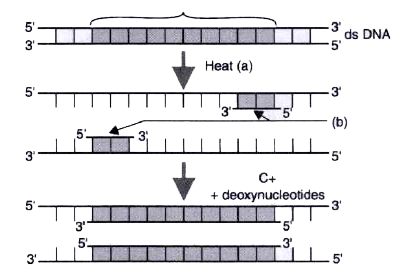Rearrange the following in the correct sequences to accomplish an important biotechnological reaction:
a) In vitro synthesis of copies of DNA of interest
b) Chemically synthesized oligonucleotides.
c) Enzymes DNA polymerase
c) Complementary region of DNA.
e) Genomic DNA template
f) Nucleotides provided.
g) Primers
h) Thermostable DNA-polymerase (from Thermus aquaticus).
i) Denaturatioin of ds-DNA.
i), e), g), b) ,c), h), f) ,d), a)
Topper's Solved these Questions
- BOOK - PRADEEPCHAPTER - BIOTECHNOLOGY: PRINCIPLE'S AND PROCESSESEXERCISE - LONG ANSWER QUESTIONS10videos
BIOTECHNOLOGY: PRINCIPLE'S AND PROCESSES
- BOOK - PRADEEPCHAPTER - BIOTECHNOLOGY: PRINCIPLE'S AND PROCESSESEXERCISE - ANALYTICAL QUESTIONS WITH ANSWERS20videos
BIOTECHNOLOGY: PRINCIPLE'S AND PROCESSES
- BOOK - PRADEEPCHAPTER - BIOTECHNOLOGY: PRINCIPLE'S AND PROCESSESEXERCISE - ADDITIONAL QUESTIONS VERY SHORT ANSWER QUESTIONS28videos
BIOTECHNOLOGY: PRINCIPLE'S AND PROCESSES
- BOOK - PRADEEPCHAPTER - BIOTECHNOLOGY AND ITS APPLICATIONS EXERCISE - NCERT EXERCISES PRACTICE QUESTION (II. Assertion Reason Type Question)14videos
BIOTECHNOLOGY AND ITS APPLICATIONS
- BOOK - PRADEEPCHAPTER - ENVIRONMENTAL ISSUESEXERCISE - PRACTICE QUESTIONS (ASSERTION-REASON TYPE QUESTIONS)7videos
ENVIRONMENTAL ISSUES
Similar Questions
Rearrrange the following in the correct sequence to accomplish an important biotechnological reaction:
( a) In vitro synthesis of copies of DNA of interest
(b) Chemically synthesized oligo - nucleqtides
( c) Enzyme DNA - polymerase
( d) Complementary region of DNA
( e) Gernomic DNA template
(f) Nuceltides provided
( g)Primes
(h) Thermostable DNA -polymerase (from Thermus aquaticus )
( i) Denaturation of ds- DNAView SolutionRearrange the following in the correct sequence to accomplish an important biotechnological reactions :
(a) In vitro synthesis of copies of DNA of interest
(b) Chemically synthesized oligonucleotides
(C) Enzyme DNA-polymerase
(d) complementary region of DNA
(e) Genomic DNA template
(f) Nucleotides provided
(g) Primers
(h) Thermostable DNA-polymers (from Thermus aquaticus)
(i) Denaturation of ds-DNAView Solution
Knowledge Check
- Question 1 - Select One
The synthesis of RNA primer complimentary to the DNA template strand is assisted by:
a) Primase
b) DNA polymerase III
c) Helicase
d) LigaseAPrimaseBDNA polymerase IIICHelicaseDLigase - Question 2 - Select One
Among the following, select the tools of recombinant DNA technology
a. Restriction enzymes b. Polymerase enzymes
c. Ligases d. Vectors
e. Host organismsAa, b, c, d and eBa, c, d and eCa, b, c and dDa, b, c and e - Question 3 - Select One
Which of the following statement are correct for the enzyme Taq polymerase?
(i) It remains active during the high temperature .
(ii) It requies primers for carrying out the process of polymerization.
(iii) It induces denaturation of double-stranded DNA.A(i) and (ii)B(i) and (ii)C(i),(ii) and (iii)D(ii) and (iii)
A schematic representation of polymerase chain reaction (PCR) up to the extension stage is given below.

Which of the following has popularized the PCR (Polymerase Chain Reaction) ?
a) Easy availability of DNA template
b) Availability of synthetic primers
c) Availability of cheap deoxyribonucleotides
d) Availability of thermostable DNA polymerase.View SolutionIn the following questions , a statement of assertion (A) is followed by a statement of reason (R).
A:Thermostable enzyme Taq polymerase is used during annealing step of PCR.R: This heat tolerant enzyme helps primers to hydrogen bond to complementary DNAView SolutionRead the following statements-
(A)- The base pairing confers a very unique property to the polynucleotide chains of DNA i.e complementarity,(B)- Each strand from a DNA acts as a template for synthesis of a new strand.View SolutionWhich of the following is/are part of biotechnology?
A. Correcting a defective gene .
B.Developing a DNA vaccine
C. In vitro fertilisation
D.Synthesis of a gene.View SolutionWhich of the following is/are part(s) of biotechnology?
A. in vitro fertilisation
B. synthesis of a gene
C. correcting a defective gene
D. developing a DNA vaccineView Solution

